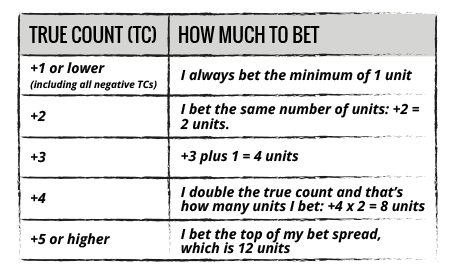Card Counting Teams
- Doing this makes card counting impossible because a counter can never establish the penetration needed to get an accurate count. As a result, fewer and fewer blackjack teams can be found in the casinos today.
- Card counting is a system that experienced blackjack players use to get a profitable advantage over the casino. There are many individual “counts” or systems. Many of them are named after colorful professional gamblers from times past. The 2008 movie “21” bought card counting to.

Professional gambling syndicates are usually reserved for casino and horse-race tracks that gather investors who pool their money and invest together. They are usually successful because the public loves to gamble and casinos have a house edge to back them up. Pari-mutuel races usually hold 17% for expenses. That’s a nice way to go!
The MIT blackjack team is probably the most famous group of professional players in the game of blackjack and the sport of card counting. This site would not be complete if we didn't write a little bit about them and what the true story was behind the famous blockbuster '21' movie.
Card Counting System
For professional gamblers, the numbers aren’t nearly as strong. A solid blackjack card counter expects to hold somewhere close to a 1% edge over the house. Advantage players who use shuffle tracking methods can expect a much higher edge, similar to a blackjack team that employs the “Big Player” approach where the counters are managing the count on several different tables at minimum wages and the money player comes in and bets the table maximum only when the count is just right. When this method is applied the players’ (team) edge is well over 2%, and that’s why a team can attract investors.
In addition, the return can be very quick. Teams of six to eight players can double a modest bankroll in less than a week when everything goes well with only about a 5% element of ruin (total loss of bankroll). Ken Uston, one of the best big players and team administrators ever seen, played off and on for ten years and only lost three bankrolls – one due to theft and one due to a lack of training. The real blackjack odds only beat the teams once!
You as an Individual Blackjack Player

If you are trying to build a bankroll for yourself to try and exploit the bonuses found at online casinos, you might start small and try one online casino after another, bucking the house edge but savoring the big bonuses offered. Keep in mind that they have to try and balance what they offer and the percentage allowed (often only 10% of each wager with 30x rollover) at blackjack to still make a profit. You’ll have an uphill climb every time, but some luck and a steady increase of wagers when winning and determination might make you some money.
Playing in land casinos after learning basic strategy would be similar to playing online, but you won’t have the bonuses. It will be fun, and you’ll get some comps back if you play in North American casinos, but to make any real headway you’ve got to put the time into mastering a card counting system, even if it is just a simple Aces and Fives count.
Once you have the edge, even a tiny part of one-percent, you’ll gain an average hourly income. The trick is to keep most of your winnings in your bankroll so it can grow. Counting cards for a living is a tough go because you have to earn enough to grow your bankroll and pay your living expenses. It’s much easier to have a regular job and keep your gambling bankroll separate.
Remember that with a 1% edge over the house you will have substantial ups and downs, but you can only expect to make 1% of your overall wagers in the long run. That means if you wager $10 to $50 and have an average wager of $20, you’ll make about $20 in profits for every 100 hands you play. The larger your bankroll, the smaller element of ruin you’ll have, but a good rule of thumb is to assume you need 400-units of your minimum wager to keep from ever busting, assuming you reassess your bankroll and minimum and maximum wagers after every session. This means you’ll always have less than a 5% element of ruin, which if continually recalculated, means you really have very little chance of losing your entire bankroll. Of course your win rate won’t be high enough to get to large wagers very quickly, that’s why team play and shared bankrolls are so powerful.
Playing and Sharing Blackjack Bankrolls
Obviously there are several things that go into having a successful blackjack team or partnership. Trust is one aspect, because you’ll be dealing with the emotions of gambling and real cash. Another important aspect is player ability. No sense going partners with someone who can’t win because they don’t play well enough. The third most important aspect is time. Sharing a bankroll allows each individual player a common fund of cash and the average wager can be slightly higher (10 to 20%), so having several players in action tends to smooth out the bumps and gets you to your financial goals quicker.
Two-player and three-player partnerships are common, and easy to maintain. Each player invests their cash for a shared pool to play to, and wagers are increased as the bankroll grows. Often a small hourly rate is paid to each player so there is incentive to play instead of letting the other guy do all the work. If all investments are equal, the win is evenly split when the goal is reached. Occasionally the partners may just continue taking an hourly rate indefinitely, ideally seeing the bankroll grow and their hourly pay increase steadily over time.


The other way of investing is more popular with larger groups, but money is invested with the goal of doubling the bankroll and players continue in action until the goal is reached. That’s why players need to have money and time to invest.
Big Player Teams
Team play is the toughest for casinos to pick up on, and also the most lucrative for players. With this type of gambling team, several investors put their money into a shared bankroll and administer a team of players. A team of six or eight players can breeze through a town like Atlantic City for a week and hardly be noticed. With eight players, six will be counters, each on different tables playing the minimum wager on six-deck shoe games and keeping the count, and two players will bet the big money, when the counters call them (discreetly) into positive-count shoes. This allows a $10 minimum wager on all hands by the counter and $500 to $1000 hands by the Big Player when the team has the edge.
It is the huge bet variation and large average wager that both fools the casinos and makes the team money. There can be six counters on different tables and two big players wandering about at any time either in one casino or split between two casinos. Even with eight players, if the Big Player can get in just a few hours of play each session with an average $500 wager, teams can double a bank quickly.
Administering a Blackjack Team
Counting Cards Blackjack
If you want to put together a few investors and players and give it a go, here is an idea of how one team of five counters and one Big Player might be financed:
- Two outside investors put up $2000 each
- You and Five counters put up $1000 each
- Play until bankroll is doubled
- No bankroll funds are used for personal expenses
- $10,000 total bankroll allows initial top wager of $100 to $200
That top wager of $100 looks pretty small and would indicate that doubling the bankroll would take about 200 hours (your Big Player will get in less than half as many hands as your counters) to achieve, but that’s deceiving. As the bankroll grows, the big player’s wager increases. Although the game is streaky and no definitive rates are guaranteed, a team of players could see this:
The Big Player wagers a percentage of the bankroll that equals the player’s edge (counters call them in at 1 to 2% edge). After 10 hours the team bankroll is $11,500, allowing wagers to climb to $150 to $250. After 10 more hours the bankroll is $14,000 allowing wagers of $200 to $300. Another 10 hours brings the bankroll to $16,000 and wagers are raised to $250 to $400. These numbers are slightly inflated, but a good run of luck would see the next 20 hours doubling the bank.
That’s 50 hours of play for a $10,000 win. The bankroll is shared 50-50 with investors, so each person who invested gets paid first: investors get $1000 each and you and five counters get $500 each. The other half of the win is split-up by hours played. The Big Player usually gets double hours, so with five counters and the Big Player there are 350 hours invested and $14 per hour. That makes $24 per hour for the counters total with their investment return, and you as the Big Player and investor make $34 per hour. Want to reinvest with a little higher bankroll now that you see the possibilities?
Obviously a team that has two sets of three counters and a Big Player at different casinos can double the bankroll faster and increase the overall pay rate for players.
The most important part of building a professional card counting bankroll is reaching a fair split with players and investors. You have to have people you can trust with lots of cash, and they have to be able to play the game under stressful situations.